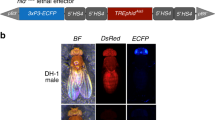Abstract
As part of a study on the suitability of translocations for insect pest control, artificial selection was applied for either higher or lower egg hatchability in each of the reciprocal matings between a translocation heterozygote and a translocation homozygote. In each of four selection lines, there was response to selection but, after 3–4 generations, limits were reached beyond which further selection gave no response. On reversing the directions of selection, the high and low lines rapidly exchanged their levels of egg hatchability and then established new plateaux. Relaxation of selection caused convergence towards the original unselected level. It is concluded that individuals with extremely high or low fertility were disfavoured by natural selection. Populations initiated from two different translocation homozygotes formed a stable polymorphism and after propagation in bottles for 10 generations, small increases were found in the fertility of the double translocation heterozygotes compared with the same genotype newly produced from unselected homozygote stocks. It is concluded that, under the conditions of the bottle cultures, natural selection favoured increase in fertility of the double heterozygotes.
Similar content being viewed by others
References
CURTIS, C. F. (1968). Possible use of translocations to fix desirable genes in insect pest population. Nature, 57, 509–523.
ERK, F. C. (1960). A study of genetic control over segregation in a translocation heterozygote inDrosophila. Genetics, 45, 986.
FALCONER, D. S. (1960).Introduction to Quantitative Genetics. Oliver and Boyd, Edinburgh.
HOSSAIN, M. A. and CURTIS, C. F. (1974). The effect of selection on the fertility of translocation heterozygotes in the House Fly. J. Med. Entomol., in press.
IVES, P. T. (1965). Drosoph. Inf. Serv., 40, 35.
KRISHNAMURTHY, B. S. (1974). Construction of “integrated” strains ofCulex pipiens fatigans Wied. for genetic control.J. Comm. Dis. 6, 76–79.
LAVEN, H. (1968). Genetische methods zur Shadlilngsbekampfung. Anz. F. Schadlingsk., 41, 1–7.
LAWRENCE, C. W. (1958). Genotypic control of chromosome behaviour in rye. IV. Selection for disjunction frequency. Heredity, 12, 127–131.
LERNER, I. M. (1954).Genetic Homeostasis. Oliver and Boyd, Edinburgh.
LEWIS, K. R. and JOHN, B. (1957). Studies onPeriplaneta americana II. Interchange heterozygosity in isolated populations. Heredity, 11, 11–22.
RENNER, O. (1925). Untersuchungen über die faktorielle Konstitution einiger Complex-heterozygotischerOenotheren.Bibliotheca Genet., 9, 1–168.
ROBINSON, A.S. (1971). A study of chromosome translocations inDrosophila. Ph. D. Thesis, University of Bristol.
ROBINSON, A.S. and CURTIS, C. F. (1972). Crossing over in a double translocation inDrosophila.Canad. J. Genet. Cytol., 14, 129–137.
ROBINSON A. S. and CURTIS, C. F. (1973). Controlled crosses and cage experiments with a translocation inDrosophila.Genetica, 44, 591–601.
SEREBROVSKII, A. S. (1940). On the possibility of a new method for the control of insect pests.Zool. Zh., 19, 618–630.
SUN, S. and REES, H. (1967). Genotypic control of chromosome behaviour in rye. IX. The effect of selection on the disjunction frequency of interchange associations.Heredity, 22, 249–254.
Author information
Authors and Affiliations
Rights and permissions
About this article
Cite this article
Hossain, M.A., Curtis, C.F. & Jaffe, W.P. Selection on the fertility of translocation heterozygotes inDrosophila melanogaster. 1. The extent of the changes produced by selection. J Genet 61, 205–217 (1974). https://doi.org/10.1007/BF02986432
Issue Date:
DOI: https://doi.org/10.1007/BF02986432




